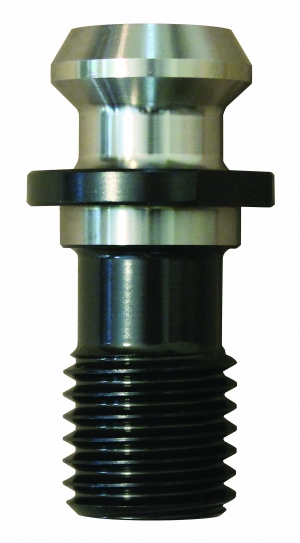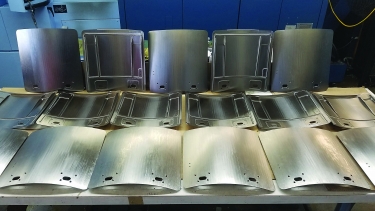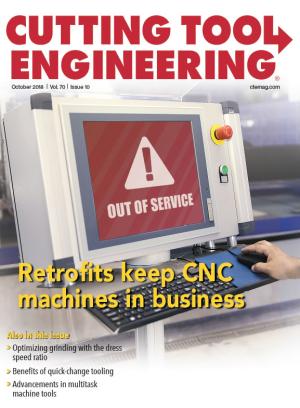Demand for titanium, stainless steel and other difficult-to-cut workpiece materials is on the rise for components in vital growth industries, such as aerospace, medical and automotive. To compete, parts manufacturers typically must machine these parts at spindle speeds in excess of 20,000 rpm. Vibration and chatter can occur at these rates of speed, leading to poor surface finishes that require secondary bench operations to meet finish specifications and avoid critical damage to expensive workpieces.
Additional factors, such as an unbalanced toolholder or a toolholder improperly seated within the spindle, can dramatically reduce material-removal rates and increase cycle times. Even minor flaws in toolholder fit or concentricity can reduce part quality and cutting tool and spindle life.

A High Torque retention knob from JM Performance Products. Image courtesy of JM Performance Products
Stability is essential to achieve optimal results when milling challenging materials. The entire machining process must be considered. Any one element could impede the overall effectiveness of the process. The cutting tool, holder, spindle, machine tool, fixturing and workpiece are all part of the interconnected “machining circle.”
After investing in a Matsuura H.Plus-405 horizontal machining center, Delta Machine Co. LLC, Gardena, California, realized that one critical factor to not breaking this circle is to have a properly balanced toolholder in the spindle, said President Janos Garaczi. When he purchased the HMC, Garaczi followed the machine builder’s recommendation and purchased High Torque retention knobs from JM Performance Products Inc., Fairport Harbor, Ohio. The knobs, which enhance the seating of a holder in the spindle, are longer and reach deeper into the cross section of the holder’s threaded bore than standard retention knobs, JMPP reports. As a result, all thread engagement occurs in a region of the toolholder where the cross section is thicker to resist deformation.
Since 1980, Delta has specialized in high-volume production of complex parts. While working as a Delta shop foreman, Garaczi purchased the machine shop from his retiring boss in 2016. “The first thing I did was look for better customers and try to see what kind of equipment we could invest in because we only had old equipment,” Garaczi said, noting that his customers include Boeing, Tesla and Chevrolet.
About 80 percent of what Delta machines is titanium, mostly Ti6Al4V, Garaczi said. The rest is stainless steel (15 percent) and aluminum. He wanted to rough-machine as fast as possible, especially when cutting titanium, which consumed about 90 percent of production time.
After purchasing the HMC, “work just started flowing in,” Garaczi said, and he began buying more machines: a Matsuura H.Plus-500 HMC, three 5-axis Matsuura MX-520 vertical machining centers and a Toyoda FH550SX HMC. “I just ordered a Makino A7 HMC,” he added. “We are extremely busy.”

High Torque retention knobs help Delta Machine impart fine surface finishes and eliminate secondary benching operations. Image courtesy of Delta Machine
With the purchase of each machine, Delta continued to buy more High Torque retention knobs. Although they cost about three to four times more than a standard knob, the payback through longer tool life, shorter cycle times and finer surface finishes is quick, Garaczi said. “Even if you pay $4,000 more for 200 knobs, it’s going to bring this money back in a couple of months—easily. For us, it’s a no-brainer.”
He estimates that the retention knobs from JMPP help increase tool life from 20 to 30 percent and eliminate the need for secondary benching operations. One part for the Boeing 737 MAX program, for example, required about 3 hours of bench work to blend the machined surfaces when another machine shop produced it, Garaczi said. After Delta received the job, bench work wasn’t necessary.
“One day, the head inspector saw the first article and started touching it,” Garaczi said. “The first thing the guy said was, ‘You don’t need to produce such a good finish.’ Without any benching, we can achieve a surface finish of 32 to 40 rms.”
He added that the High Torque retention knobs help Delta boost its cutting speeds. “We’ve been able to cut cycle times by 40 to 50 percent compared to other shops.”
On its old milling machines, Delta cut titanium at about 80 ipm. On the newer high-speed machining centers, Delta can reach 200 ipm with the right milling cutter. However, Garaczi emphasized the need to balance tool life and cutting speed to reach the “sweet spot” that maximizes profit. He estimates that tool life is cut in half when going from 100 to 150 ipm in titanium and that tool life drops 40 percent further when going from 150 to 200 ipm.
“The reduction in cycle time did not justify the increase in tool cost,” he said. “In titanium, your tooling costs are much higher than when machining aluminum. I would say almost 10 times the cost.”
Savings are also potentially realized by avoiding spindle damage when a machine’s high torque shears off or breaks the retention knob, which is a scenario Garaczi said he’s heard about for standard knobs. Replacement spindles cost $40,000 or more, not including the cost of downtime. “And that’s not covered by the manufacturer’s warranty.”
Although Garaczi pointed out that retention knobs from JMPP help significantly enhance rigidity and minimize vibration when machining difficult-to-cut metals, Delta’s use of dual-contact spindles, high-quality tools and toolholders, the right coolant, the best fixtures, high-speed machining centers and efficient toolpaths all play a critical role.
Related Glossary Terms
- centers
centers
Cone-shaped pins that support a workpiece by one or two ends during machining. The centers fit into holes drilled in the workpiece ends. Centers that turn with the workpiece are called “live” centers; those that do not are called “dead” centers.
- chatter
chatter
Condition of vibration involving the machine, workpiece and cutting tool. Once this condition arises, it is often self-sustaining until the problem is corrected. Chatter can be identified when lines or grooves appear at regular intervals in the workpiece. These lines or grooves are caused by the teeth of the cutter as they vibrate in and out of the workpiece and their spacing depends on the frequency of vibration.
- coolant
coolant
Fluid that reduces temperature buildup at the tool/workpiece interface during machining. Normally takes the form of a liquid such as soluble or chemical mixtures (semisynthetic, synthetic) but can be pressurized air or other gas. Because of water’s ability to absorb great quantities of heat, it is widely used as a coolant and vehicle for various cutting compounds, with the water-to-compound ratio varying with the machining task. See cutting fluid; semisynthetic cutting fluid; soluble-oil cutting fluid; synthetic cutting fluid.
- cutting speed
cutting speed
Tangential velocity on the surface of the tool or workpiece at the cutting interface. The formula for cutting speed (sfm) is tool diameter 5 0.26 5 spindle speed (rpm). The formula for feed per tooth (fpt) is table feed (ipm)/number of flutes/spindle speed (rpm). The formula for spindle speed (rpm) is cutting speed (sfm) 5 3.82/tool diameter. The formula for table feed (ipm) is feed per tooth (ftp) 5 number of tool flutes 5 spindle speed (rpm).
- gang cutting ( milling)
gang cutting ( milling)
Machining with several cutters mounted on a single arbor, generally for simultaneous cutting.
- inches per minute ( ipm)
inches per minute ( ipm)
Value that refers to how far the workpiece or cutter advances linearly in 1 minute, defined as: ipm = ipt 5 number of effective teeth 5 rpm. Also known as the table feed or machine feed.
- machining center
machining center
CNC machine tool capable of drilling, reaming, tapping, milling and boring. Normally comes with an automatic toolchanger. See automatic toolchanger.
- milling
milling
Machining operation in which metal or other material is removed by applying power to a rotating cutter. In vertical milling, the cutting tool is mounted vertically on the spindle. In horizontal milling, the cutting tool is mounted horizontally, either directly on the spindle or on an arbor. Horizontal milling is further broken down into conventional milling, where the cutter rotates opposite the direction of feed, or “up” into the workpiece; and climb milling, where the cutter rotates in the direction of feed, or “down” into the workpiece. Milling operations include plane or surface milling, endmilling, facemilling, angle milling, form milling and profiling.
- milling cutter
milling cutter
Loosely, any milling tool. Horizontal cutters take the form of plain milling cutters, plain spiral-tooth cutters, helical cutters, side-milling cutters, staggered-tooth side-milling cutters, facemilling cutters, angular cutters, double-angle cutters, convex and concave form-milling cutters, straddle-sprocket cutters, spur-gear cutters, corner-rounding cutters and slitting saws. Vertical cutters use shank-mounted cutting tools, including endmills, T-slot cutters, Woodruff keyseat cutters and dovetail cutters; these may also be used on horizontal mills. See milling.
- sawing machine ( saw)
sawing machine ( saw)
Machine designed to use a serrated-tooth blade to cut metal or other material. Comes in a wide variety of styles but takes one of four basic forms: hacksaw (a simple, rugged machine that uses a reciprocating motion to part metal or other material); cold or circular saw (powers a circular blade that cuts structural materials); bandsaw (runs an endless band; the two basic types are cutoff and contour band machines, which cut intricate contours and shapes); and abrasive cutoff saw (similar in appearance to the cold saw, but uses an abrasive disc that rotates at high speeds rather than a blade with serrated teeth).
- toolholder
toolholder
Secures a cutting tool during a machining operation. Basic types include block, cartridge, chuck, collet, fixed, modular, quick-change and rotating.
End User: Delta Machine Co. LLC, 310-323-8207, www.deltamachineco.com
Solution Provider: JM Performance Products Inc., 440-357-1234, www.jmperformanceproducts.com
Challenge: Reduce cycle times, extend tool life and impart finer finishes when machining complex titanium parts.
Solution: High-performance retention knobs, along with dual-contact spindles, in high-speed, high-torque CNC machining centers.








